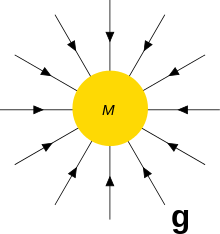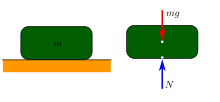Science: An Elementary Teacher’s Guide/Mass, Weight, and Inertia
Mass, Weight, and Inertia
[edit | edit source]Mass
[edit | edit source]Mass is a property of any physical object, from components of atoms to entire planets or stars. While it is related to weight, it is not the same thing, because weight is dependent on other objects in the system, while mass is not (for example, you have a different weight on the moon than on the earth, but you are the same mass in both places). It is difficult to define mass without talking about weight, but another way to think about it is that mass is the measure of an object's resistance to acceleration (a change in its state of motion) when a force is applied--this can best be understood by thinking of pushing on a massive object, like a refrigerator, compared to pushing on something smaller, like a book. Even in a situation without gravity (astronauts on a spacewalk), a massive object will still be harder to accelerate than a small object (an astronaut will have to apply more force to a bowling ball to accelerate it to 10 mph than to a tennis ball). The larger the mass, the more resistant to changing its state of motion (which is also why a large truck uses much more gasoline than a small car). Mass also determines the strength of its mutual gravitational attraction to other bodies (you may not realize that you are attracting the earth towards you, just like the earth is attracting you towards it--you are attracting the earth towards you, but the earth is so much more massive than you that all we can notice is you being pulled towards the earth, not vice-versa). In the theory of relativity, a related concept is the mass–energy content of a system (we won't be explaining relativity, but Einstein's famous E = mc2 relates energy to mass). The SI unit (meaning the standard, international metric unit) of mass is the kilogram (kg). Mass is a property of atoms (mainly the protons and neutrons), so atoms with different numbers of protons and neutrons will differ in mass (in other words, a block of lead or gold will have more mass than a block of aluminum that is the same size).
Mass is not the same as weight, even though we often calculate an object's mass by measuring its weight with a scale, rather than comparing it directly with known masses. An object on the Moon would weigh less than it does on Earth because of the lower gravity, but it would still have the same mass. This is because weight is a force (the force of gravity), while mass is the property that (along with gravity) determines the strength of this force.
In Newtonian physics, mass can be generalized as the amount of matter in an object (for our purposes, mass is a function of how many and what type of atoms are in an object). However, at very high speeds, special relativity postulates that energy is an additional source of mass (back to Einstein's equation).

When a force is applied to an object, the reaction of that object can be predicted with a simple formula:
Formula of Newton's Second Law of Motion: F = ma
Newton's second law of motion describes the relationship between an object's mass and the amount of force needed to accelerate it. The force 'F' is equal to the mass 'm' multiplied by 'a' the acceleration (how much an object is speeding up or slowing down, measured in m/sec2. You could rearrange this to calculate mass if you know the force and the acceleration (m = F/a), or if you know mass and acceleration desired, you could calculate the force needed. Example: How much force is applied to a baseball by a professional pitcher for it to accelerate to 95 mph? We need to know the mass of a baseball, which is about 145 g (which is 0.145 kg). We also need to know that 95 mph is about 42.5 m/s. Now, technically that is the velocity at one moment, not the acceleration (it started at zero and it sped up to 95 mph). Acceleration is m/s2, meaning how many meters per second faster is it going this second than the last second? For simplicity we will assume the baseball went from 0-95 mph in one second, so that we can use a = 42.5 m/s2. So: F = ma = (0.145kg)(42.5m/sec2) = 6.16 kgm/sec2. That's a weird unit: kgm/sec2. We call it the Newton! So, a professional baseball player must exert a force of 6.16 N (Newtons). Another example: a 1400 kg car that accelerates at 2/sec2. 2 m/s is about 10 mph, so every second the car is going 10 mph faster (meaning 0-50 mph in 5 seconds)..
The nearer the object is to the center of the earth, the stronger the force of gravity on an object is (so technically there is less gravity on top of a mountain than down at the beach, but the difference is small--but if you go into space you will notice a big difference). If you fall from an airplane, you will accelerate at a rate of 9.8 m/s2. You will not speed up forever--the faster you go, the more resistance from all the air molecules you are hitting.
Weight
[edit | edit source]The gravitational force of an object is called weight. The most common definition of weight found in introductory physics textbooks defines weight as the force exerted on a body by gravity. This is often expressed in the formula w = mg, where w is the weight, m the mass of the object, and g gravitational acceleration (9.8 m/s2). The gravitational force of an object is stronger when the object is closer to the center of the Earth. With this fact, an object weighs less at the top of a high elevated mountain rather than it would at a low elevation. For example an airplane and its passengers weighs slightly less as it ascends to higher elevation rather than what it would on the ground.

Inertia
[edit | edit source]Experiment Performed by Prof. Oliver Zajkov at the Physics Institute at the Ss. Cyril and Methodius University of Skopje, Macedonia.
Inertia is defined as a tendency to do nothing or remained unchanged. It is a word that is used when matter and movement is brought up. Inertia brings up Newton's first two laws of physics:
- An object at rest tends to stay at rest, while an object in motion tends to stay in motion.
- The force exerted is directly proportional to the mass and accleration of the body. (i.e, )
Inertia is directly related to mass. For example, the greater the mass, the harder it is to start an object moving or to change the object's speed or direction. If you want to overcome inertia, you have to apply a force. A force will make something that is still start to move, like flicking a wad of paper with a pencil will make it move. Also force must be used to slow or stop something that is already moving. If you throw a ball you do not need to run after it and slow it down by pulling on it--it will be slowed by the force of gravity bringing it to the ground and the force of resistance (friction) made by rubbing up against the air it is passing through and against the ground as it rolls. Without gravity or air resistance the ball would just continue traveling--this is why satellites in space continue in orbit for years and years, at amazing speeds, without having to use any fuel.
Newton's First Law of Motion explains how inertia affects moving and nonmoving objects. Newton's first law states that an object will remain at rest or move at a constant speed in a straight line unless it is acted on by an unbalanced force. You can understand all of Newton's laws best in low-friction environments, like a pool table (there is still friction--when you hit a ball it will not roll forever, but it is low friction so the balls roll easily). Inertia is a function of mass. Objects with more mass have more inertia and require more force to move (put a bowling ball on your pool table and try using your pool cue with the same force as you would against a billiard ball). The bowling ball probably has 50 times more mass than the billiard ball, so it has 50 times more inertia. You can also feel inertia every day when riding in a car. What happens if the car comes to a sudden stop? Your body was in motion with the car, and your body has inertia. When the car stops, you keep on moving forward--this is why we wear seat belts! What happens when the car starts moving? Because of inertia, your body tends to stay at rest when the car moves forward, which feels like you are pushed back in the seat (in truth you were not pushed back--you were staying still and the car pushed forward against you).

